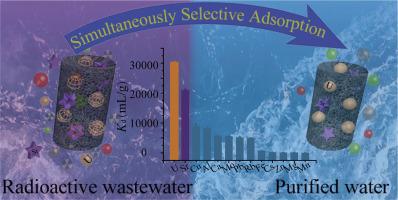Separation and Purification Technology ( IF 8.6 ) Pub Date : 2021-04-28 , DOI: 10.1016/j.seppur.2021.118849 Jia Yin , Sen Yang , Weiwei He , Tongxin Zhao , Chengqi Li , Daoben Hua

|
Recovery of multiple radionuclides from radioactive effluents is extremely important for either environmental protection or sustainable development of nuclear energy. In this work, we report a strategy of simultaneously selective removal of uranium(VI) and strontium(II) from simulative highly saline low level radioactive effluents employing co-imprinting method. Specifically, a novel aerogel (U/Sr-IP) is imprinted with uranium(VI) and strontium(II) from biogenic dopamine and sodium alginate. The aerogel shows better selectivity for uranium(VI) and strontium(II) against other cations compared with non-imprinted polymer. The maximum adsorption capacities are calculated from Langmuir models to be 317 and 160 mg/g for uranium(VI) and strontium(II), respectively. Simultaneously selective adsorption of uranium(VI) and strontium(II) saves the time and space in dealing with complex radioactive wastewater. Noteworthily, when the concentration of sodium chloride (1 mol/L) is five times than that of radioactive effluents, 83% of the adsorption capacity is maintained even after 5 recycles. After the adsorption, uranium(VI) and strontium(II) are eluted by Ca(NO3)2 and Na2CO3 successively, which makes the aerogel more practical by sequential elution. The prepared U/Sr-IP is an efficient and competitive adsorbent in harsh environment, displaying a promising application in removal of radionuclides from highly saline low level radioactive effluents. This work demonstrates a concept of simultaneously selective adsorption of two or more radionuclides for the first time.
中文翻译:

共印迹法同时提取铀(VI)和锶(II)的生物基因衍生气凝胶
从放射性废液中回收多种放射性核素对于环境保护或核能的可持续发展都极为重要。在这项工作中,我们报告了一种使用共压印方法从模拟高盐度低水平放射性废水中同时选择性去除铀(VI)和锶(II)的策略。具体而言,一种新型气凝胶(U / Sr-IP)上印有来自生物多巴胺和藻酸钠的铀(VI)和锶(II)。与非压印聚合物相比,气凝胶对铀(VI)和锶(II)对其他阳离子的选择性更好。根据Langmuir模型计算,铀(VI)和锶(II)的最大吸附容量分别为317和160 mg / g。同时选择性吸附铀(VI)和锶(II)可以节省处理复杂放射性废水的时间和空间。值得注意的是,当氯化钠的浓度(1 mol / L)是放射性流出物的浓度的五倍时,即使经过5次循环,其吸附容量仍可保持83%。吸附后,用Ca(NO)洗脱铀(VI)和锶(II)3)2和Na 2 CO 3连续,这使得气凝胶通过顺序洗脱更加实用。制备的U / Sr-IP在恶劣的环境中是一种高效且具有竞争力的吸附剂,在从高盐度低水平放射性废水中去除放射性核素方面显示出广阔的应用前景。这项工作首次展示了同时选择性吸附两种或多种放射性核素的概念。



























 京公网安备 11010802027423号
京公网安备 11010802027423号